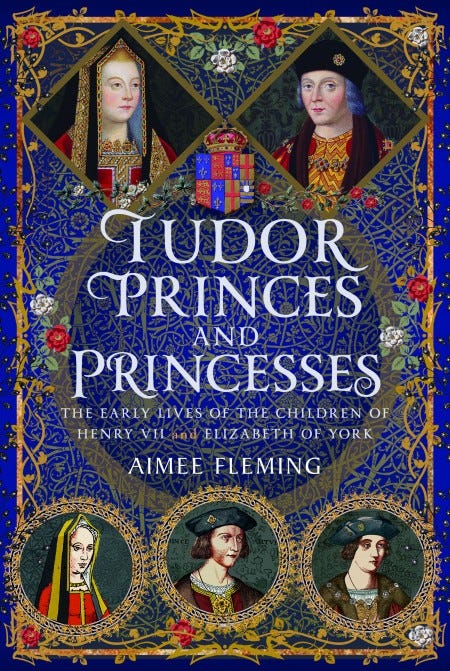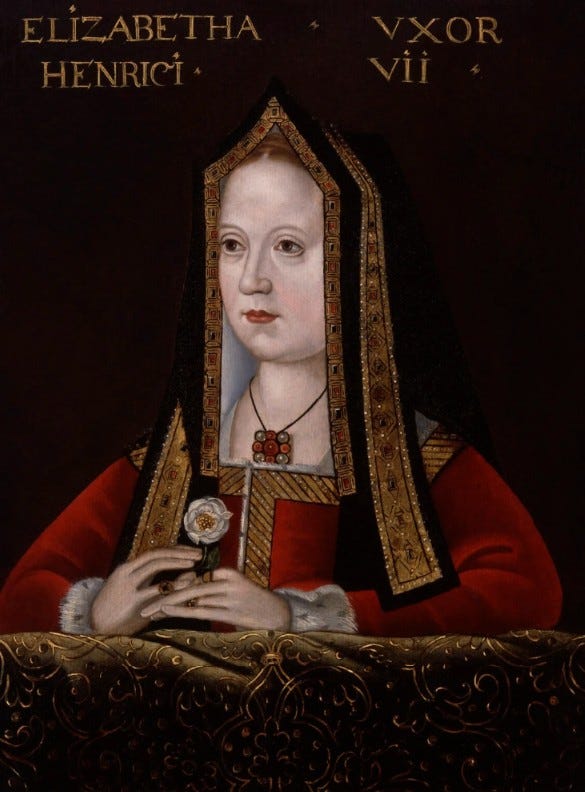Guest Post with Aimee Fleming
Author of 'Tudor Princes and Princesses: The Early Lives of the Children of Henry VII and Elizabeth of York'
Princess Elizabeth: The Forgotten Tudor
Today I welcome back Aimee Fleming to my blog and Substack. Aimee has previously been a guest on my blog writing about her first book on Margaret More Roper. You can read Aimee’s previous post here. Aimee’s new book Tudor Princes and Princesses: The Early Lives of the Children of Henry VII and Elizabeth of York was released earlier this month and Aimee is here to write about one of the lesser-known children of Henry VII and Elizabeth of York – Princess Elizabeth Tudor (not to be confused with the future Elizabeth I!). Over to Aimee …

Some names were common in Tudor England, which can sometimes make singling out individuals a little tricky. If people from the past share names, they can become confused, intertwining with each other in the public memory, or in some cases they can be forgotten almost completely.
And this is the case of Princess Elizabeth Tudor. There are Elizabeths all over the Tudor family line; Elizabeth of York married Henry VII, and Henry VIII’s younger daughter of course went on to be Elizabeth I but was Princess Elizabeth Tudor before she took the throne. However, there was another Elizabeth, who appears between these two memorable ladies, and who shared their name and left her own mark on Tudor history.
Princess Elizabeth Tudor was born on the 2nd July 1492 at the palace of Sheen in London. She was the fourth child of Henry VII and Elizabeth of York, making them a family of two sons and two daughters. It almost seemed perfect, and the little family were elated by her arrival that summer. Celebrations and a full christening took place, although as a fourth child, perhaps they wouldn’t have been quite such extravagant events as they were for her siblings.
Elizabeth joined the nursery soon after she was born, joining her sister Margaret, who was then almost 3, and her brother Henry who was just a year old. They would have spent all their time together, entertained and cared for by a group of handpicked nurses and maids, and visited often by their parents who were never too far away. The children travelled between royal palaces of Sheen, Eltham and Greenwich; they were well away from the city of London with its diseases and cramped streets but also close enough that the royal family could see each other often, and the children would be brought to court for state events and celebrations.
However, this idyllic set up did not last long. On the 14th September 1495, while the King and Queen were away in Northamptonshire on progress, Elizabeth died suddenly. There doesn’t seem to have been any sign of Illness, and no doctor was called to Eltham Palace where the royal children were in residence. Her death was shock to everyone; Henry VII had been on the throne for a decade, and his little dynasty had grown at a steady rate. There was no reason to think that that situation would change.


When news of Elizabeth’s death reached the King and Queen, they were understandably upset, but they did not return to London. Instead, they ordered that Elizabeth’s body stay at Eltham while arrangements for a grand funeral were made. She was placed in the Chapel at Eltham, draped in black velvet covered in the Tudor Rose emblem, and guarded day and night, with prayers said over her constantly. She stayed there for eleven days, until on September 26th, she was moved in a hearse drawn by 6 horses to me met at Westminster Abbey by the prior and monks from the Abbey. She was accompanied on the journey by her nurses, by those who had looked after her throughout her short life, but the rest of the family did not attend.
The following day an elaborate funeral service took place, with Westminster Abbey packed with mourners who gathered to pay their respects to the little princess. After the service, her body was placed in a tomb in the Abbey itself, most likely originally in the chapel of St Edward the Confessor, and a plaque was placed on a small plinth near the tomb of Henry III. The plaque has since been lost, but records from the eighteenth century have it as saying:
‘Elizabeth, second child of Henry the Seventh King of England, France and Ireland and of the most serene lady Queen Elizabeth his consort, who was born on the second day of the month of July in the year of Our Lord 1492, and died on the 14th day of the month of September in the year of Our Lord 1495, upon whose soul may God have mercy. Amen.’
While the death of a child wasn’t an unusual occurrence in the sixteenth century, Elizabeth’s sudden death would have been a shock to a family who, up until then, hadn’t known personal sorrow. Politically, 1495 was a bad year for Henry, who was challenged by rebellions and pretenders to his throne, so the loss of a child on top of this political instability would have made the stress and strain on the entire family much worse.
Some good news did follow for the family however, as Elizabeth was pregnant again and she gave birth to a healthy little girl in March 1496, Princess Mary. However, the loss of Elizabeth was always in the consciousness of the entire Tudor family, and despite her young age she made an impression on them all. One way we can tell that they maintained that connection was through her belongings, which were re-used or kept by the family. The drapes that were used for Elizabeth while she lay in state were re-used at court on the death of her younger brother Prince Edmund in 1500, and again following the death of Prince Arthur in 1502.
Elizabeth’s death marks the start of a new period in the Tudor dynasty and the reign of Henry VII, as over the next few years more losses followed, and more instability plagued the family. While Elizabeth herself may not be mentioned often, perhaps her early death, and the others experienced by the young Tudors, can explain why Henry VIII particularly took such care and control over their own children’s health and well-being.
Author Bio
Aimee is a historian and author from North Yorkshire. She is a married Mum of three and has worked in history and heritage throughout her career. She completed an MA in Early Modern History as a mature student and has since written two books and is currently working on her third.
Social Media:
Website - https://historyaimee.wordpress.com/
Substack - Aimee Fleming
Instagram - @historyaimee
Blue Sky - @historyaimee.bsky.social
Threads - @historyaimee
Facebook – Aimee Fleming
Aimee’s books:





